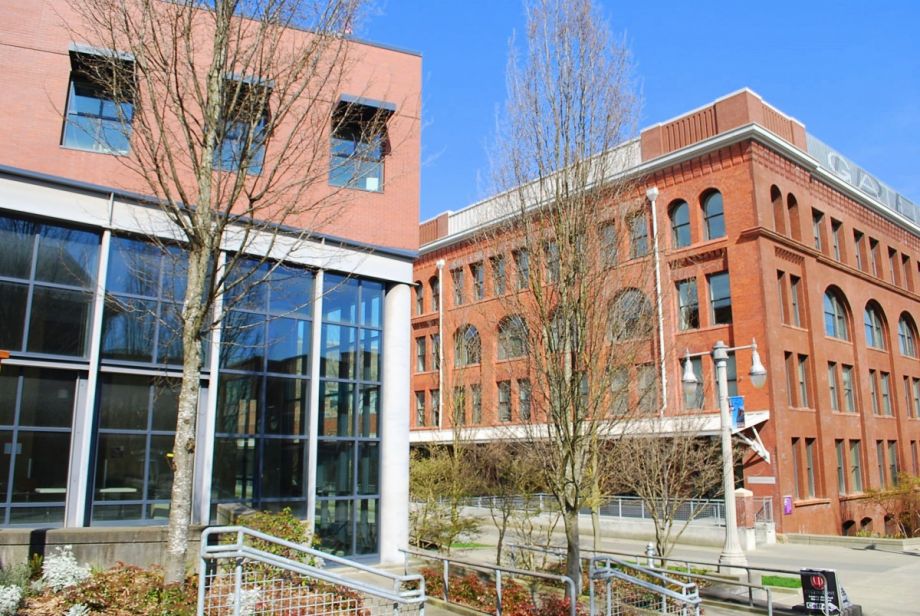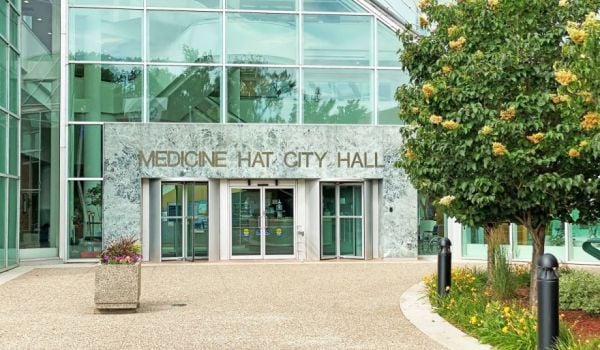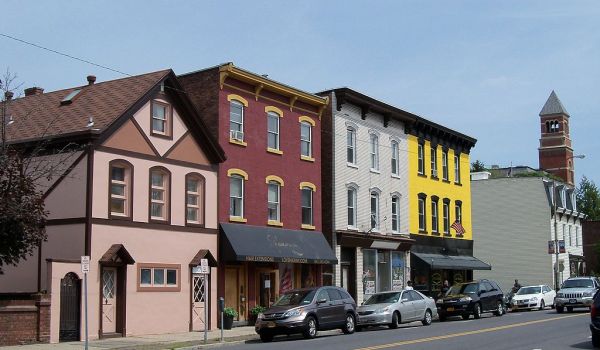At the beginning of the spring 2020 semester, the chancellor at the University of Washington Tacoma sent out an advisory to students: “If you or someone you know is dealing with housing issues that might interfere with the ability to succeed in school,” it said, “a new program could help.”
A new apartment building had just opened, ten minutes’ walk from campus, and 63 of its 152 units would be subsidized for students who were homeless or housing-insecure — struggling regularly to pay rent or utilities, moving frequently, or living in substandard housing. It was the second year in a row that a new development opened near campus with some of its small apartments set aside for low-income students. And the apartments are small — as little as 250 square feet for a studio in the building that opened last year.
“When I went inside, I thought, ‘Oh my goodness, this wouldn’t even hold my office,’” says Mentha Hynes-Wilson, the vice chancellor for student affairs at UWT. “But the feedback we’re getting from students is that it is really meeting their needs.”
Typically, the studios start at around $800 a month. But through the College Housing Assistance Program at the Tacoma Housing Authority, some students are eligible for subsidized housing units, in the range of $400 to $800 a month, based on income. The CHAP program was launched as a pilot in 2014, with 47 homeless or “near homeless” students at Tacoma Community College (TCC) receiving housing vouchers to use on the private market, providing a flat subsidy based on their household size. Over the next two years, the Authority tracked those students’ performance, along with the performance of 154 students in similar positions who didn’t receive housing assistance. At the end of that period, according to the Authority, 60 percent of the participants had graduated or remained enrolled, as opposed to 16 percent of the students who didn’t receive assistance. And the GPA for the pilot group was 3.05, as opposed to 2.75 for the larger group. The pilot was later expanded at TCC, and it was made available to UWT students, many of whom transfer from the community college, in 2018.
Housing insecurity among college students is a growing concern, particularly on the west coast, where the general lack of affordable housing affects huge portions of the population. A report released by the Wisconsin HOPE Lab in 2018 found that, according to a national survey, 12 percent of community college students were homeless, and around half were housing-insecure. Last year, California legislators briefly considered a bill that would have required community colleges to let students sleep in their cars in campus parking lots overnight, a sign both of how dire the housing problem had become and how few viable solutions had been found.
The early results of the College Housing Assistance Program in Tacoma have caught the attention of other housing authorities and colleges around the country. The program was named one of the top 25 “Innovations in American Government” by The Harvard Kennedy School Ash Center for Democratic Governance and Innovation in 2018.
According to Karen Bunce, a department manager at the Tacoma Housing Authority, the College Housing Assistance Program grew out of a casual conversation between the Authority’s director and the dean of one of the local colleges about student homelessness. Around the same time, researchers were beginning to look at issues of food insecurity and housing instability among college students, including surveying students at Tacoma Community College.
The program expanded at TCC. Originally limited to up to three years of subsidy for students who remain enrolled, the program was extended to allow up to five years of subsidy in 2019. Some students can access a year of housing assistance after graduating as well, assuming they don’t exceed five years of assistance in total.
“We continue to believe this is an excellent program that leverages public housing dollars to alleviate barriers for this important group of students,” Tamyra Howser, executive director of marketing and communications at TCC, said in an email.
As the high-cost of housing spread out from nearby Seattle, some students have had a hard time finding housing even with vouchers, Bunce says. So the housing authority also began working directly with developers to create unit-based subsidies, like those in the new buildings near the University of Washington Tacoma. Today, according to Jess Thompson, a project manager at the Tacoma Housing Authority, the Authority subsidizes 189 units and administers an additional 100 tenant-based vouchers to local students.
Sara Goldrick-Rab, the founding director of the Hope Center for College, Community, and Justice at Temple University in Philadelphia, was an author of the Wisconsin HOPE Lab study that found an alarming number of Tacoma Community College students experiencing homelessness or housing insecurity. Today, Goldrick-Rab and the Hope Center are involved in evaluating the College Housing Assistance Program in Tacoma. The researchers are tracking around 100 people who were homeless at the time they applied for the program, and around 300 who were near-homeless, Goldrick-Rab says. About half of the people in the evaluation have received assistance, she says. The researchers are surveying the students every six months, and hoping the results will clarify the extent to which the program is successful and worth emulating. The Center has already started publishing guidelines based on what it has learned from the Tacoma partnership, and Goldrick-Rab says it’s planning to publish its first results from the long-term surveys in about a year and a half.
“[The program] is a really creative, and I think smart, use of government funding, but again we just don’t know yet,” Goldrick-Rab says.
Most housing authorities have strict rules about how they can spend funding for housing choice vouchers, but the Tacoma Housing Authority is one of 39 housing authorities that are part of the Moving To Work Demonstration Program, which lets authorities experiment with locally tailored programs. The Moving to Work program was created to make federal housing assistance more cost-effective, incentivize programs that help families with children, and expand housing choices for low-income families. It has allowed agencies to experiment with a range of initiatives targeting temporary vouchers to certain low-income populations, like homeless college students. But it also has raised concerns that the more flexible rules allow Moving to Work agencies to help fewer families than they otherwise would. A report by the Center on Budget and Policy Priorities in 2017, for example, showed that Moving to Work agencies helped 68,000 fewer families than they would have if they had spent all their voucher funding the way typical authorities do. Targeted programs like Tacoma’s do show a lot of promise in helping people, says Will Fischer, a senior policy analyst at the CBPP who wrote the report. But expanding the overall funding for Housing Choice Vouchers would be a better way to provide housing than allowing agencies to experiment with more limited programs, he says.
“We have a lot of evidence showing that the voucher program in its current form is really effective in helping low-income people stabilize their lives …” Fischer says. “I don’t think there’s anything from the things that have been tested at Moving to Work agencies that suggest we should change the basic model for the voucher program.”
Still, as Tacoma waits for the results of the professional evaluation, Mentha Hynes-Wilson says student feedback is encouraging, with some UWT students reporting better “mental well-being.” But there’s a stigma to overcome, she says. Homelessness is often associated with mental illness, drug abuse, and the tent cities in nearby Seattle, she says, and those associations can prevent students who are struggling from accurately assessing their own conditions.
The school doesn’t have a database of homeless students and probably never will, Hynes-Wilson says, but it is trying to foster a “help-seeking culture,” where students are encouraged to take advantage of university services that can make their lives more stable. The university has created a marketing campaign, and some professors have begun including information about university services in their syllabi, Hynes-Wilson says. She worries about scaling up those programs, and finding ways to help more students access housing as the regional housing crisis unfolds. But so far, so good.
“We know we’re having an impact, and we know it’s a positive impact,” she says.
Editor’s note: This story was updated to clarify details about the amount and length of assistance available to students through the College Housing Assistance Program. Update 2/11/20: We’ve updated this article to add comment from TCC.
This article is part of Backyard, a newsletter exploring scalable solutions to make housing fairer, more affordable and more environmentally sustainable. Subscribe to our weekly Backyard newsletter.

Jared Brey is Next City's housing correspondent, based in Philadelphia. He is a former staff writer at Philadelphia magazine and PlanPhilly, and his work has appeared in Columbia Journalism Review, Landscape Architecture Magazine, U.S. News & World Report, Philadelphia Weekly, and other publications.
Follow Jared .(JavaScript must be enabled to view this email address)


















